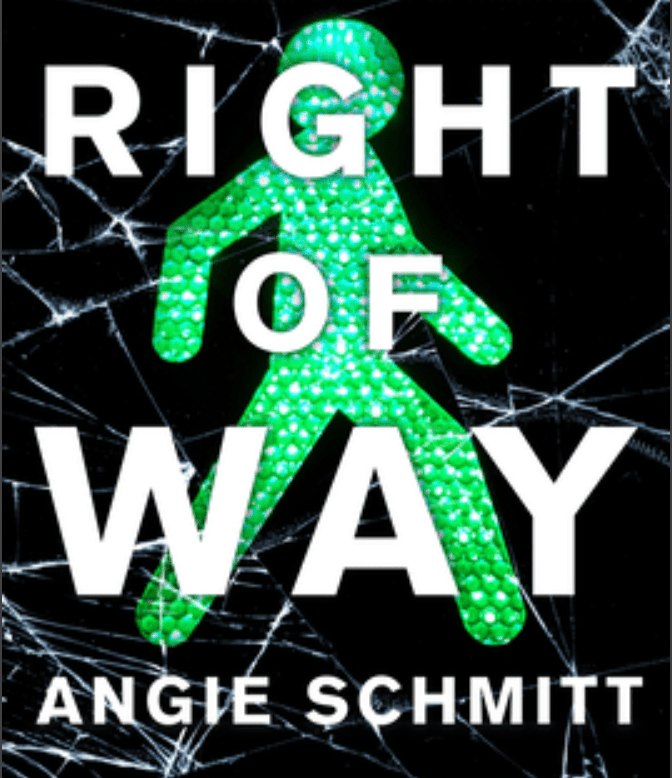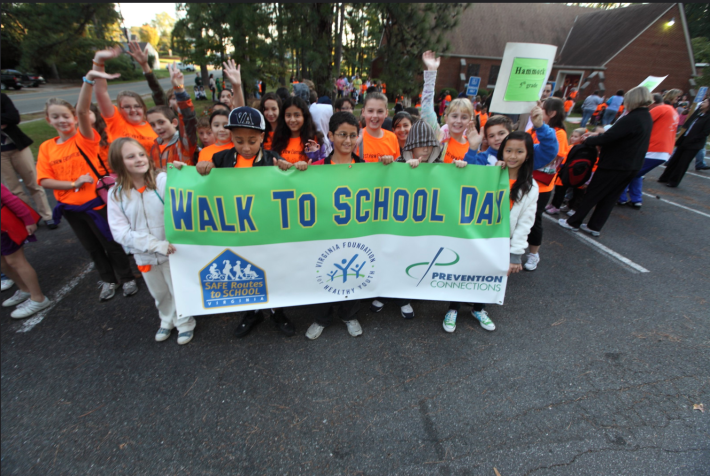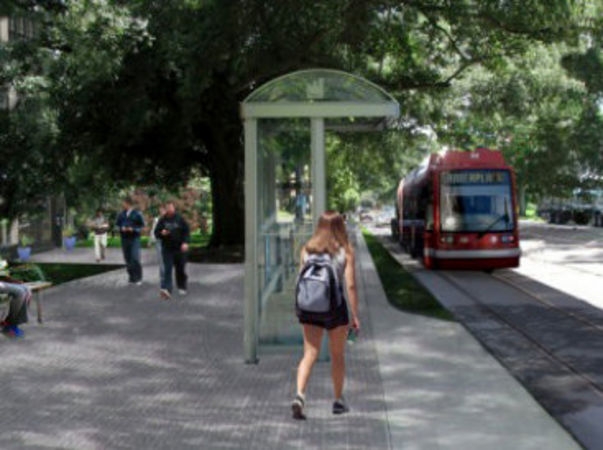A Hard Right Turn: The Moment the U.S. DOT Abandoned U.S. Walkers
3:50 PM EDT on August 20, 2020

The following is an excerpt from the forthcoming book Right of Way by former Streetsblog USA editor and internationally recognized sustainable transportation expert Angie Schmitt. It will be published on Thursday, August 27; preorder your copy today on Island Press, Indiebound, or anywhere else books are sold.
On October 3, 2015, five hundred elementary students convened in the parking lot of Biggs Park Mall in Lumberton, North Carolina. There, outside the JCPenney, Foot Locker, and GNC, in the county seat of Robeson County, a lower-income manufacturing region, they prepared to do something that is increasingly unusual in the United States: walk to school.
Of the 235 schools that took part in Walk to School Day across North Carolina, this October event—the fruit of successful collaboration between the state Department of Transportation and Division of Health—was the biggest ever. There to cheer on Tanglewood Elementary students as they began their half-mile journey were many of Lumberton’s notable people as well as “Rocky the Bear,” the mascot of the local hospital district, which helped sponsor the event.
It was a lot of ceremony and preparation for a half-mile walk, but it reflects just how unusual walking to school has become in the United States. During the late 1960s, 48 percent of US schoolchildren got to school by foot or bicycle, but by 2009, the number had dropped to just 13 percent.
The idea behind Safe Routes to School, a federally sponsored transportation program dating to 2000, is that a little encouragement can make a difference. North Carolina’s Safe Routes to School program had been offering support to schools like Tanglewood for years, providing not just pep rallies, but safety training for students and, on occasion, physical infrastructure upgrades, like crosswalks.
But in 2018, just as the pedestrian safety crisis in the United States was reaching its height, North Carolina officials slashed the program’s budget by 90 percent. A state transportation official told a reporter, “We are committed to this program and the tenets of this program” but that the state’s hands were tied, in part, by changes to federal regulations.
State officials were referring to an obscure federal funding program passed in 2012. That year, just as pedestrian deaths were beginning their as-yet-uninterrupted climb, lawmakers in Washington, DC, signed a two-year, $105 billion national surface transportation spending package that weakened already meager federal support for biking and walking.
The spending bill, known by the shorthand acronym MAP-21, eliminated Safe Routes to School as a stand-alone program. It was folded into a larger program called “Transportation Alternatives,” funded at just over $800 million a year. That dollar figure—amounting to a 33 percent cut from $1.2 billion—would become the total federal support for walking and biking. States could still offer Safe Routes to School, if they chose, but they would have less federal support.

Keep in mind that 2012 was a time of intense national interest in walking and biking. Census estimates show that biking to work, for example, had increased 60 percent between 2008 and 2012. Around this era, in 2014, the New York Times wrote an article about bike culture among young urban dwellers (“the bike-to-work generation”) that was influencing mainstream fashion.
But that kind of cultural zeitgeist did not seem to register in the US Senate. In September 2011, for example, Tom Coburn, then a Republican senator from Oklahoma, attempted to block a vote authorizing all highway spending unless his amendment, which called for zeroing out all federal support for biking and walking, was brought up for a vote.
Even prior to this era, though, the safety of people on bicycle or foot was never really considered a core federal transportation concern. That, said Andy Clarke, who was head of the League of American Bicyclists from 2003 to 2013, was partly because of the two lobbying groups with the greatest power in Washington transportation discussions: highway builders and state transportation officials. “Highway guys would say, ‘Why are we frittering away money on this stuff that isn’t real?’” Clarke said.
Meanwhile, state departments of transportation, like the Georgia Department of Transportation, and their professional associations for the most part offered only limited support. “Generally speaking, state DOTs and the people who work there just really don’t feel like this is their responsibility, along with historic preservation and environmental protection and equity stuff,” Clarke said. “It’s a sense that it’s just subverting their core mission of building highways for cars.”
Safe Routes to School—being a small, safety-related program aimed at children—had never been subject to attack before, however. It was first introduced in the late days of the Clinton administration and survived the George W. Bush presidency with little challenge. Up to this point, the partisan divide on biking and walking had not been very apparent. But 2012 was an antagonistic moment in the nation’s capital. When MAP-21 passed, it was near the height of the Tea Party Obama backlash, shortly after Republicans took back the House of Representatives. “Bike-pedestrian issues were more the easy target,” Clarke said. “The bike and ped stuff is 1 percent of the budget.”
The reasons for that are subject to debate. Overall, party polarization has been growing. In addition, urban-rural partisan division has become more entrenched, said Clayton Nall, associate professor of political science at the University of California, Santa Barbara. “Back in the day, the Republican Party was actually pushing urban policy,” he said. “Corporate friendly urban policy, like opportunity zones.”
Since then, however, the Republican Party has become more overtly anti-urban. Based on survey data of Americans’ political attitudes, it is unclear when and why that happened, but there has been a shift, said Nall. “White flight has had this result of leaving very few white swing voters in urban areas who would benefit from this kind of spending,” he said. “Because there are so few Republican voters in cities anymore . . . which is where a lot of these debates over bike and pedestrian infrastructure are happening . . . the Republican Party no longer sees who this would appeal to.”
Generational gaps may also play a role. Beginning in the early 2000s, there was a celebrated movement—by the media, anyway—away from driving and toward walking and biking, especially among younger generations. “Congestion and the high cost of car ownership may have cooled the romance between Americans and their cars, especially for younger adults,” Mary Wisniewski at the Chicago Tribune wrote in 2018.

Wisniewski was citing a survey sponsored by Allstate that showed that more than half of millennials thought that a car was not worth the cost of upkeep and that they would rather be doing something other than driving. But whatever young people’s preferences—and rising housing costs in “walkable” transit-friendly areas do suggest a growing preference—younger people do not have the political clout, it seems, to put those values into practice. Despite millennials’ stated preferences to drive less, Allstate’s survey showed that they drive about as many miles as their parents: only 13 percent reported they could “live without access to a vehicle.”
Meanwhile, Congress was getting increasingly older. The average age of a member of the 116th US Congress was fifty-seven. For US Senators, the average age was just shy of sixty-three, according to Quorum Analytics.
It is also possible that Republican opposition to biking, walking, and transit investment simply arose to some extent in response to growing interest in these modes in more progressive Democratic strongholds like New York City and Portland. Nall said that the survey data point to a sea change in partisan opinion around alternatives to driving around 2010. “This was around the time Republicans like [former Wisconsin Governor] Scott Walker were killing off High Speed Rail,” which had been proposed and passed early in Obama’s term as part of the stimulus bill, he said. “There’s this message that cars are crucial to the American way of life and that Democrats are trying to engage in social engineering.”
Whatever the underlying cause, Republican-led assaults on transportation funding continued throughout the Obama administration and beyond. In 2015, for example, as Congress was gearing up to pass another transportation bill, Americans for Prosperity and a number of other right-wing groups associated with the infamous dark money political donors Charles and David Koch wrote a letter to Congress calling for total elimination of federal walking and biking funds.
They might have succeeded, given the new Republican majorities in the House and Senate, were it not for Rick Larsen, congressman from Washington state, who rallied minority Democrats on the House Transportation Committee to refuse to advance any bill that eliminated federal support for biking and walking.
By 2015, when the bill was passed, pedestrian deaths were already 25 percent higher than they had been just five years prior, but the issue failed to register in federal negotiations. That year, Congress passed a mostly status-quo extension of the 2012 bill, leaving cuts to biking and walking mostly in place. That bill—the FAST Act, it was called—continues to fund US transportation programs today.
The lack of federal support for pedestrian safety is costly. In 2010, the National Highway Traffic SafetyAdministration (NHTSA) estimated the social and economic costs of traffic crashes to be about $836 billion. The share that would be related to walking and biking injuries would be roughly $125 billion. In other words, bike and pedestrian crashes cost Americans the equivalent of about $400 per person per year in 2010. Since that time, pedestrian fatalities have increased dramatically.
Pedestrians and cyclists now account for about one in five traffic deaths in the United States. But these modes receive just about 1.5 percent of federal transportation funding, or about $2.65 per American per year.
Austerity Meets Crisis
By 2018, the damage of some of these policies was apparent, even if no one in Washington was explicitly acknowledging the connection. That year was the most deadly year for pedestrians in a generation. But even as the crisis accelerated, states like North Carolina were scaling back their already anemic support.
In 2018, North Carolina officials slashed $13.5 million from the state’s $15 million budget for Safe Routes to School. Part of the problem, they explained, was that MAP-21 required the state to provide a 20 percent match for federal funds for the program. In the years after 2012, the state had been able to use leftover funding to make the match, but now that funding had run out. In addition, North Carolina transportation officials had political obstacles at the state level to continuing support for the program.
In 2011, a supermajority of Republicans had been elected to the North Carolina Statehouse. Two years later, in 2013, they passed a law saying that no stand-alone bike or pedestrian project would be eligible for state funding. “We have not had one single dollar go to bicycle or pedestrian projects in any part of the state” since then, said Terry Lansdell, the executive director of BikeWalk NC.
Prior to 2013, North Carolina had been making progress on bike and pedestrian safety, trying to tie it to other statewide health and welfare programs. Smart Growth America recently named North Carolina the seventh most dangerous state in the country for pedestrians and cyclists, and the loss of funding, said Lansdell, “hurts dramatically.”
There was yet another painful effect of the 2012 federal spending bill: in addition to slashing total support, it made investing in biking and walking optional for states—to a big degree. The law (MAP-21) allowed states to transfer up to half of their transportation alternatives funding to other things, like highway projects, and many chose to do so.
In a single quarter in 2017, for example, eight states—Alabama, Connecticut, Iowa, Louisiana, New Hampshire, Nevada, Oregon, and Wisconsin—transferred a total of $29 million out of their transportation alternatives funding and moved it to other programs: namely, roads and highways. Margo Pedroso, deputy director of the Safe Routes to School National Partnership, said that about 20 percent of the $850 million the federal government provides to states for walking and biking projects gets transferred to roads projects. “The largest offender is Texas,” she said. “They get so much money and they transfer 50 percent pretty regularly.”
Texas does so even though it had 615 pedestrian deaths in 2017, roughly 10 percent of the national total. Each year, Texas “flexes” away about $35 million that could be used to help its embattled pedestrians and cyclists.
Following the presidential election of Donald Trump, Elaine Chao, a former Bush administration appointee and “distinguished fellow” for the Heritage Foundation, was appointed to head the US Department of Transportation (US DOT). As transportation secretary, Chao’s US DOT echoed a right-wing talking point that biking, walking, and transit were local concerns that should be funded by the local government, not the federal government. When the Republican Party wrote its 2016 presidential platform, the transportation policy recommendations were borrowed almost verbatim from the Heritage Foundation. The platform called mass transit “an inherently local affair that serves only a small portion of the population, concentrated in six big cities.” Trails and sidewalks, the platform said, “should be funded through other sources.”
Congress ignored the platform, however, and proceeded to fund transit and walking and biking at Obama-era levels. Still, Chao was able to weaken federal funding through a smaller pool of $1.5 billion discretionary funding provided to the US DOT. Chao, to a large extent, reoriented a popular $500 million Obama-era program that had funded bike and pedestrian projects toward highway spending.
During the Obama administration, the US DOT called the grant program TIGER (Transportation Investment Generating Economic Recovery) and allocated $142 million for biking and walking in a single grant cycle. In addition, nearly $400 million was awarded to “multimodal projects,” mostly road projects that had a biking or walking element. But the same grant program, renamed and run by Chao’s DOT, allocated 70 percent of the funding to roads and bridges and none—zero dollars—to walking and biking projects. What had once been a welcome source of safety funding for urban areas was neutralized.

Even so, Pedroso said that she thinks some of the worst partisan fights are in the past. She adds that biking and walking investment has recovered somewhat in recent years thanks to increased local support. “This temporary period where it became very partisan did coincide with death rates rising,” she said. “Communities could have taken steps, but they were hamstrung a little bit by federal funds.”
Fortunately, as federal biking and walking policy regressed, taxpayers in many urban (and suburban) areas were stepping up to fill the gap. Responding to the recent increased interest in walkability, a number of major metro areas passed big measures to support safer sidewalks and other biking and walking infrastructure.
In 2017, for example, Kansas City, Missouri, voters approved a bond package that included $150 million for sidewalk repairs. Atlanta passed a $150 million infrastructure bond in 2015, with $80 million in spending earmarked for “complete streets” — street safety projects that incorporate bike and pedestrian elements.
Maybe the most promising example is from Hillsborough County, Florida, home to Tampa. The greater Tampa region was ranked the ninth most deadly for pedestrians in 2019. In 2018, voters there elected to raise the sales tax by 1 percent, and the tax will generate $276 million annually, of which 12 percent is reserved for walking and biking and 45 percent is reserved for transit. The remaining funds will be dedicated to road projects. Remarkably, the roads money was specifically earmarked not for projects that increase car capacity and widen streets, but for projects that improve safety and accessibility.
“These kinds of local initiatives are bubbling up from the people saying, ‘We’ve had enough,’” Christina Barker, a volunteer activist who helped lead the effort, said following the measure’s passage. “We have some of the most dangerous streets in the country and we have next to no options for people who don’t have a car. This funding is really going to transform the city of Tampa and the county around it.” There seemed to be strong consensus for change in Tampa, and the measure passed by a ten-point margin.
Unfortunately, even in these cases, partisan acrimony can be an obstacle. That is especially true in the states that need investment the most, many of which are so-called red states. Just under a year after the Hillsborough County measure passed, José Oliva, Republican Speaker of the Florida House of Representatives, asked the Florida Supreme Court to overturn the measure. A Republican county commissioner named Stacy White had challenged the constitutionality of the ballot language. The case was heard by the state supreme court in February 2020, and a decision is forthcoming.
Tyler Hudson, a Tampa lawyer and campaign chair for All for Transportation, the citizen-led campaign that placed the transportation initiative on the ballot by petition and advocated for its passage, said that even when public consensus is clear—like 57 percent sup- port for a ballot measure—state and local Republicans cannot accept it. “State lawmakers gave Floridians the power to tax themselves to fix transportation, and when Tallahassee Republicans disagree with how voters use that power, they fight tooth and nail in court to avenge their political defeats,” he said.
From Right of Way: Race, Class, and the Silent Epidemic of Pedestrian Deaths in America by Angie Schmitt. Copyright © 2020 Angie Schmitt. Reproduced by permission of Island Press, Washington, D.C.
Angie Schmitt is the author of Right of Way: Race, Class and the Silent Epidemic of Pedestrian Deaths in America, and the former editor of Streetsblog USA.
Read More:
Stay in touch
Sign up for our free newsletter
More from Streetsblog USA
Friday’s Headlines Are Down on Highways
Two outlets recently featured articles on the harmful effects of ongoing freeway projects.
Commentary: There is Zero Ambiguity to the West Portal Tragedy
What happened in West Portal was entirely predictable and preventable. The city must now close Ulloa to through traffic and make sure it can never happen again.
Talking Headways Podcast: Details of Development Reform in Minnesota, Part I
Jim Kumon of Electric Housing discusses his work as a developer and urban policy educator in the Twin Cities.
Thursday’s Headlines Don’t Like Riding on the Passenger Side
Can you take me to the store, and then the bank? I've got five dollars you can put in the tank.
Study: When Speed Limits Rise on Interstates, So Do Crash Hot Spots on Nearby Roads
Rising interstate speeds don't just make roads deadlier for people who drive on them — and local decision makers need to be prepared.





